Long-Term Deflection Monitoring for Bridges Using X and C-Band Time-Series SAR Interferometry
Abstract
:1. Introduction
2. Study Area
2.1. Overview of Bridges
2.2. SAR Dataset
3. Application and Interpretation of PSI
3.1. Application of Time-Series PSI and Its Interpretation
3.2. Geolocation Correction
3.3. Estimation of Thermal Dilation and Long-Term Deflection Using Asc-Desc PSI
3.4. Estimation of Thermal Dilation and Long-Term Deflection Using Single Stack PSI
4. Results
4.1. PSI Displacements: Kindaejung Bridge
4.2. PSI Displacement: Muyoung Bridge
4.2.1. Thermal Dilation Analysis
4.2.2. Long-Term Deflection Analysis
5. Discussion
6. Conclusions
Author Contributions
Funding
Acknowledgments
Conflicts of Interest
References
- Takács, P.F. Deformations in Concrete Cantilever Bridges: Observations and Theoretical Modelling. Ph.D. Thesis, Fakultet for ingeniørvitenskap og teknologi, Trondheim, Norway, 2002. [Google Scholar]
- Moschas, F.; Stiros, S. Measurement of the dynamic displacements and of the modal frequencies of a short-span pedestrian bridge using GPS and an accelerometer. Eng. Struct. 2011, 33, 10–17. [Google Scholar] [CrossRef]
- Watson, C.; Watson, T.; Coleman, R. Structural monitoring of cable-stayed bridge: analysis of GPS versus modeled deflections. J. Survey. Eng. 2007, 133, 23–28. [Google Scholar] [CrossRef]
- Zhou, G.-D.; Yi, T.-H. Recent developments on wireless sensor networks technology for bridge health monitoring. Math. Prob. Eng. 2013, 2013. [Google Scholar] [CrossRef]
- Chae, M.; Yoo, H.; Kim, J.; Cho, M. Development of a wireless sensor network system for suspension bridge health monitoring. Autom. Constr. 2012, 21, 237–252. [Google Scholar] [CrossRef]
- Gentile, C. Deflection measurement on vibrating stay cables by non-contact microwave interferometer. NDT E Int. 2010, 43, 231–240. [Google Scholar]
- Pieraccini, M.; Parrini, F.; Fratini, M.; Atzeni, C.; Spinelli, P.; Micheloni, M. Static and dynamic testing of bridges through microwave interferometry. NDT E Int. 2007, 40, 208–214. [Google Scholar]
- Ferretti, A.; Prati, C.; Rocca, F. Permanent scatterers in SAR interferometry. IEEE Trans. Geosci. Remote Sens. 2001, 39, 8–20. [Google Scholar] [CrossRef]
- Berardino, P.; Fornaro, G.; Lanari, R.; Sansosti, E. A new algorithm for surface deformation monitoring based on small baseline differential SAR interferograms. IEEE Trans. Geosci. Remote Sens. 2002, 40, 2375–2383. [Google Scholar] [CrossRef] [Green Version]
- Crosetto, M.; Monserrat, O.; Cuevas-González, M.; Devanthéry, N.; Crippa, B. Persistent scatterer interferometry: A review. ISPRS J. Photogramm. Remote Sens. 2016, 115, 78–89. [Google Scholar] [CrossRef]
- Ferretti, A.; Prati, C.; Rocca, F. Nonlinear subsidence rate estimation using permanent scatterers in differential SAR interferometry. IEEE Trans. Geosci. Remote Sens. 2000, 38, 2202–2212. [Google Scholar] [CrossRef] [Green Version]
- Wang, T.; Perissin, D.; Rocca, F.; Liao, M.-S. Three Gorges Dam stability monitoring with time-series InSAR image analysis. Sci. China Earth Sci. 2011, 54, 720–732. [Google Scholar] [CrossRef]
- Reale, D.; Fornaro, G.; Pauciullo, A.; Zhu, X.; Bamler, R. Tomographic imaging and monitoring of buildings with very high resolution SAR data. IEEE Geosci. Remote Sens. Lett. 2011, 8, 661–665. [Google Scholar] [CrossRef]
- Lazecky, M.; Hlavacova, I.; Bakon, M.; Sousa, J.J.; Perissin, D.; Patricio, G. Bridge displacements monitoring using space-borne X-band SAR interferometry. IEEE J. Select. Top. Appl. Earth Observ. Remote Sens. 2017, 10, 205–210. [Google Scholar] [CrossRef]
- Del Soldato, M.; Tomás, R.; Pont Castillo, J.; Herrera García, G.; Lopez-Davalillos, G.; Carlos, J.; Mora, O. A multi-sensor approach for monitoring a road bridge in the Valencia harbor (SE Spain) by SAR Interferometry (InSAR). Rendiconti Online Societa Geologica Italiana 2016, 41, 235–238. [Google Scholar] [CrossRef] [Green Version]
- Fornaro, G.; Reale, D.; Verde, S. Bridge thermal dilation monitoring with millimeter sensitivity via multidimensional SAR imaging. IEEE Geosci. Remote Sens. Lett. 2013, 10, 677–681. [Google Scholar] [CrossRef]
- Goel, K.; Gonzalez, F.R.; Adam, N.; Duro, J.; Gaset, M. Thermal dilation monitoring of complex urban infrastructure using high resolution SAR data. In Proceedings of the 2014 IEEE Geoscience and Remote Sensing Symposium (IGARSS 2014), Quebec City, QC, Canada, 13–18 July 2014; pp. 954–957. [Google Scholar]
- Monserrat, O.; Crosetto, M.; Cuevas, M.; Crippa, B. The thermal expansion component of persistent scatterer interferometry observations. IEEE Geosci. Remote Sens. Lett. 2011, 8, 864–868. [Google Scholar] [CrossRef]
- Zhao, J.; Wu, J.; Ding, X.; Wang, M. Elevation Extraction and Deformation Monitoring by Multitemporal InSAR of Lupu Bridge in Shanghai. Remote Sens. 2017, 9, 897. [Google Scholar] [CrossRef]
- Qin, X.; Zhang, L.; Yang, M.; Luo, H.; Liao, M.; Ding, X. Mapping surface deformation and thermal dilation of arch bridges by structure-driven multi-temporal DInSAR analysis. Remote Sens. Environ. 2018, 216, 71–90. [Google Scholar] [CrossRef]
- Cluley, N.; Shepherd, R. Analysis of concrete cable-stayed bridges for creep, shrinkage and relaxation effects. Comput. Struct. 1996, 58, 337–350. [Google Scholar] [CrossRef]
- Au, F.T.; Si, X. Time-dependent effects on dynamic properties of cable-stayed bridges. Struct. Eng. Mech. 2012, 41, 139–155. [Google Scholar] [CrossRef]
- Mermigas, K.K. Behaviour and Design of Extradosed Bridges; University of Toronto: Toronto, ON, Canada, 2008. [Google Scholar]
- Wegnüller, U.; Werner, C.; Strozzi, T.; Wiesmann, A.; Frey, O.; Santoro, M. Sentinel-1 support in the GAMMA software. Proc. Computer Sci. 2016, 100, 1305–1312. [Google Scholar]
- Farr, T.G.; Rosen, P.A.; Caro, E.; Crippen, R.; Duren, R.; Hensley, S.; Kobrick, M.; Paller, M.; Rodriguez, E.; Roth, L. The shuttle radar topography mission. Rev. Geophys. 2007, 45. [Google Scholar] [CrossRef]
- Hooper, A. A multi-temporal InSAR method incorporating both persistent scatterer and small baseline approaches. Geophys. Res. Lett. 2008, 35. [Google Scholar] [CrossRef] [Green Version]
- Hooper, A.; Zebker, H.A. Phase unwrapping in three dimensions with application to InSAR time series. JOSA A 2007, 24, 2737–2747. [Google Scholar] [CrossRef] [PubMed] [Green Version]
- Gernhardt, S.; Bamler, R. Structural deformation and non-seasonal motion of single buildings in urban areas revealed by PSI. In Proceedings of the 2015 Joint Urban Remote Sensing Event (JURSE 2015), Lausanne, Switzerland, 30 March–1 April 2015; pp. 1–4. [Google Scholar]
- Huang, Q.H.; Crosetto, M.; Monserrat, O.; Crippa, B. Displacement monitoring and modelling of a high-speed railway bridge using C-band Sentinel-1 data. ISPRS J. Photogramm. Remote Sens. 2017, 128, 204–211. [Google Scholar] [CrossRef]
- Perissin, D.; Rocca, F. High-accuracy urban DEM using permanent scatterers. IEEE Trans. Geosci. Remote Sens. 2006, 44, 3338–3347. [Google Scholar] [CrossRef]
- Bovenga, F.; Belmonte, A.; Refice, A.; Pasquariello, G.; Nutricato, R.; Nitti, D.; Chiaradia, M. Performance analysis of satellite missions for multi-temporal SAR interferometry. Sensors 2018, 18, 1359. [Google Scholar] [CrossRef]
- Ozawa, T.; Ueda, H. Advanced interferometric synthetic aperture radar (InSAR) time series analysis using interferograms of multiple-orbit tracks: A case study on Miyake-jima. J. Geophys. Res. Solid Earth 2011, 116. [Google Scholar] [CrossRef] [Green Version]
- Samsonov, S.; d’Oreye, N. Multidimensional time-series analysis of ground deformation from multiple InSAR data sets applied to Virunga Volcanic Province. Geophys. J. Int. 2012, 191, 1095–1108. [Google Scholar] [Green Version]
- Mill, T.; Ellmann, A.; Kiisa, M.; Idnurm, J.; Idnurm, S.; Horemuz, M.; Aavik, A. Geodetic Monitoring of Bridge Deformations Occurring during Static Load Testing. Balt. J. Road Bridge Eng. 2015, 10. [Google Scholar] [CrossRef]
- Crosetto, M.; Monserrat, O.; Cuevas-González, M.; Devanthéry, N.; Luzi, G.; Crippa, B. Measuring thermal expansion using X-band persistent scatterer interferometry. ISPRS J. Photogramm. Remote Sens. 2015, 100, 84–91. [Google Scholar] [CrossRef] [Green Version]
- Ni, Y.; Hua, X.; Wong, K.; Ko, J. Assessment of bridge expansion joints using long-term displacement and temperature measurement. J. Perf. Constr. Facil. 2007, 21, 143–151. [Google Scholar] [CrossRef]
- Teatini, P.; Strozzi, T.; Tosi, L.; Wegmüller, U.; Werner, C.; Carbognin, L.; Rosselli, R.; Cecconi, G.; Giada, M. ERS and envisat SAR interferometry to measure land subsidence in the venice lagoon on natural and artificial point targets. In Proceedings of the Envisat Symposium 2007, ESA Communication Production Office ESTEC. Noordwijk, The Netherlands, 23–27 April 2007. [Google Scholar]
- Liu, X.; Wang, P.; Lu, Z.; Gao, K.; Wang, H.; Jiao, C.; Zhang, X. Damage Detection and Analysis of Urban Bridges Using Terrestrial Laser Scanning (TLS), Ground-Based Microwave Interferometry, and Permanent Scatterer Interferometry Synthetic Aperture Radar (PS-InSAR). Remote Sens. 2019, 11, 580. [Google Scholar] [CrossRef]
- Parcharidis, I.; Foumelis, M.; Benekos, G.; Kourkouli, P.; Stamatopoulos, C.; Stramondo, S. Time series synthetic aperture radar interferometry over the multispan cable-stayed Rio-Antirio Bridge (central Greece): Achievements and constraints. J. Appl. Remote Sens. 2015, 9, 096082. [Google Scholar] [CrossRef]
- Selvakumaran, S.; Plank, S.; Geiß, C.; Rossi, C.; Middleton, C. Remote monitoring to predict bridge scour failure using Interferometric Synthetic Aperture Radar (InSAR) stacking techniques. Int. J. Appl. Earth Observ. Geoinf. 2018, 73, 463–470. [Google Scholar] [CrossRef]
- Sousa, J.; Bastos, L. Multi-temporal SAR interferometry reveals acceleration of bridge sinking before collapse. Nat. Hazards Earth Syst. Sci. 2013, 13, 659. [Google Scholar] [CrossRef]
- Milillo, P.; Riel, B.; Minchew, B.; Yun, S.-H.; Simons, M.; Lundgren, P. On the synergistic use of SAR constellations’ data exploitation for earth science and natural hazard response. IEEE J. Select. Top. Appl. Earth Observ. Remote Sens. 2016, 9, 1095–1100. [Google Scholar] [CrossRef]
- Alvarez-Salazar, O.; Hatch, S.; Rocca, J.; Rosen, P.; Shaffer, S.; Shen, Y.; Sweetser, T.; Xaypraseuth, P. Mission design for NISAR repeat-pass Interferometric SAR. In Proceedings of the Sensors, Systems, and Next-Generation Satellites XVIII, 2013, International Society for Optics and Photonics. Dresden, Germany, 23–26 September 2013; p. 92410C. [Google Scholar]



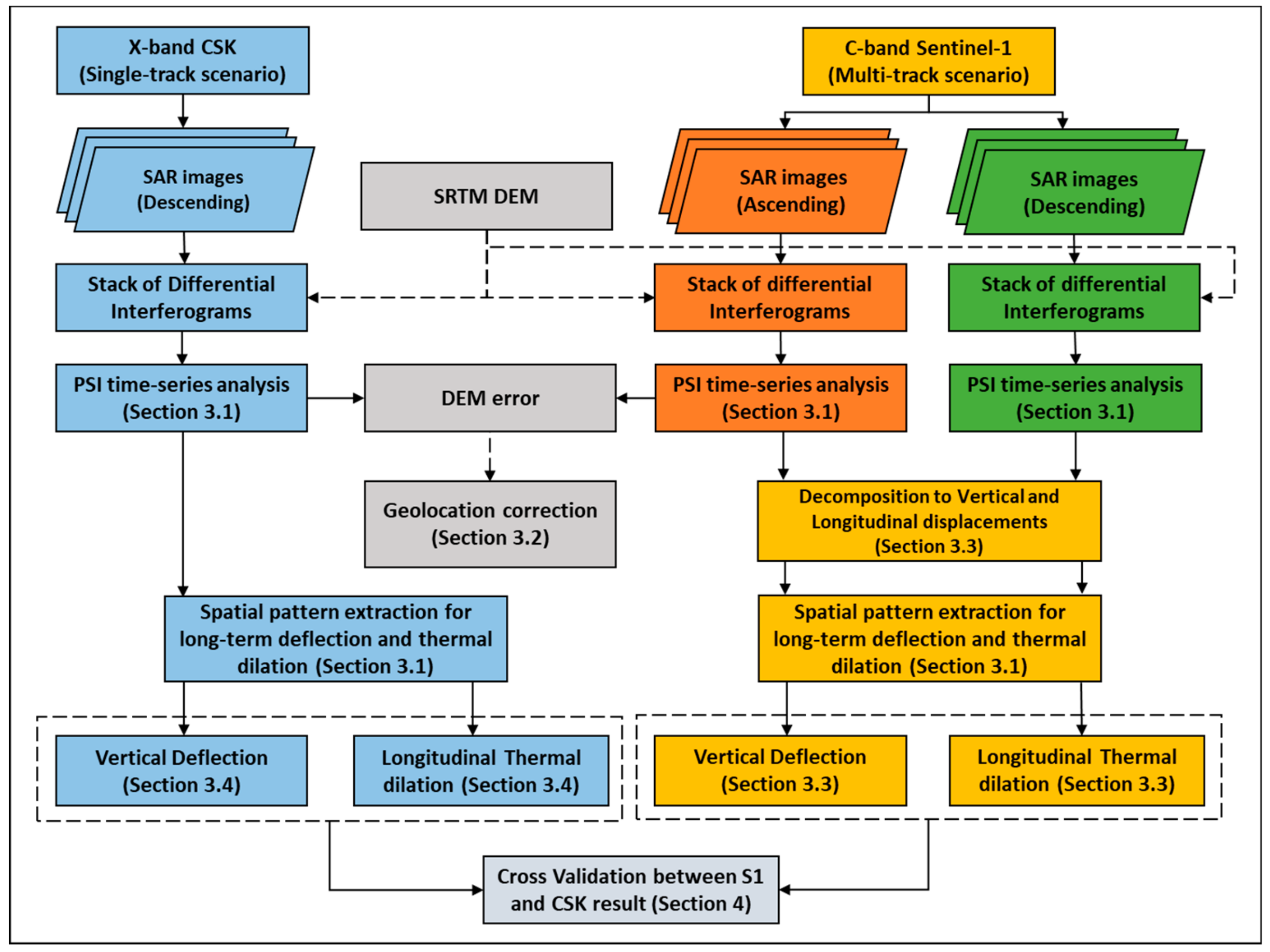
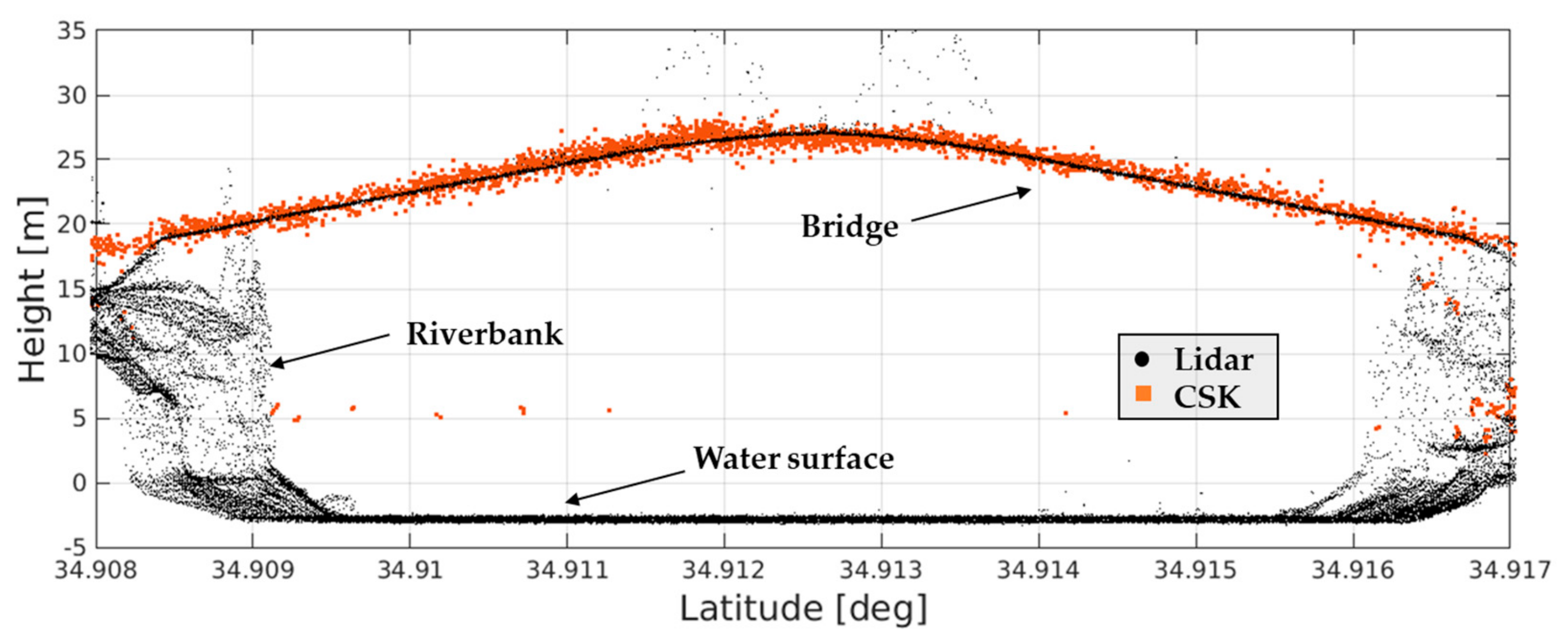

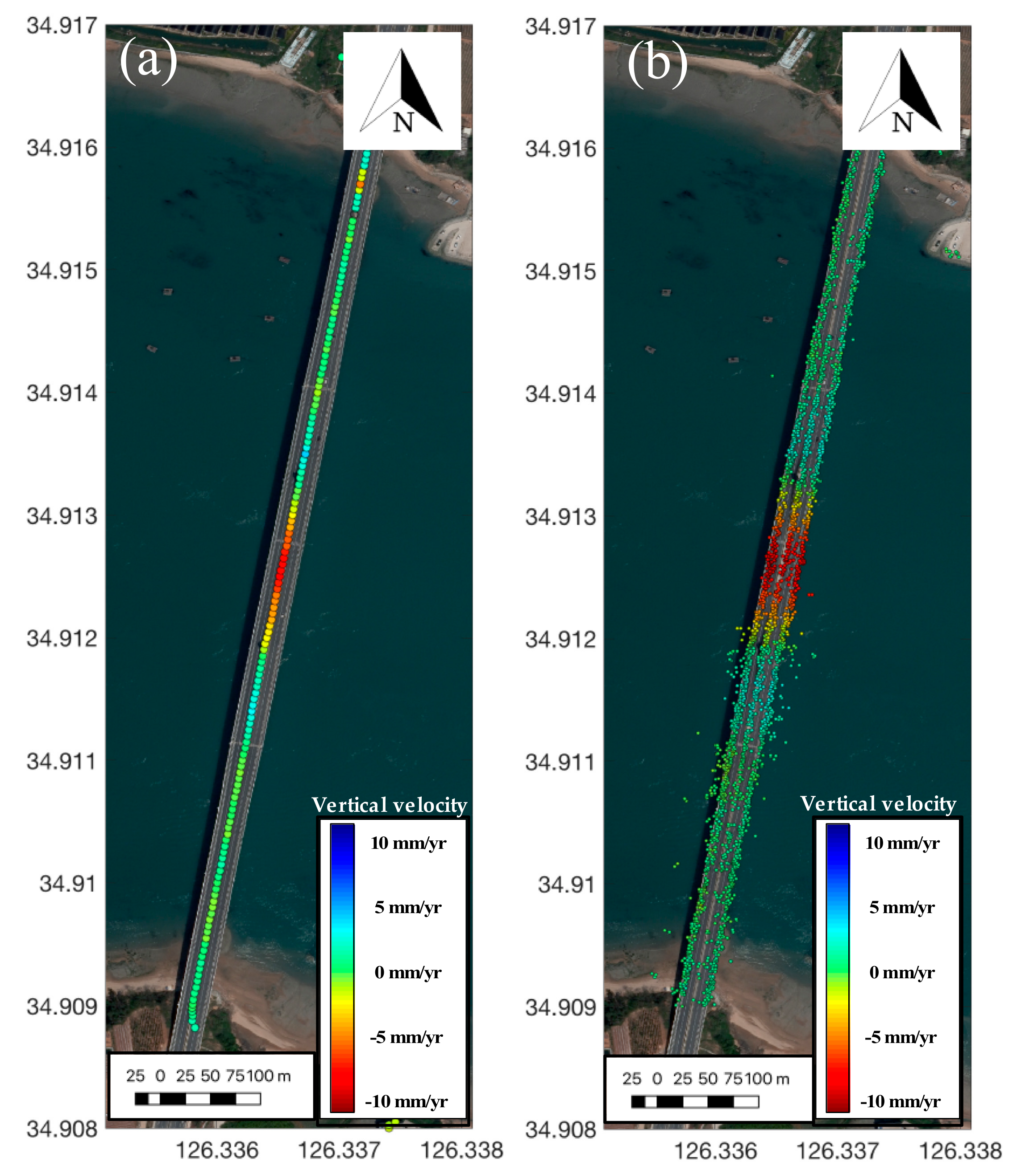
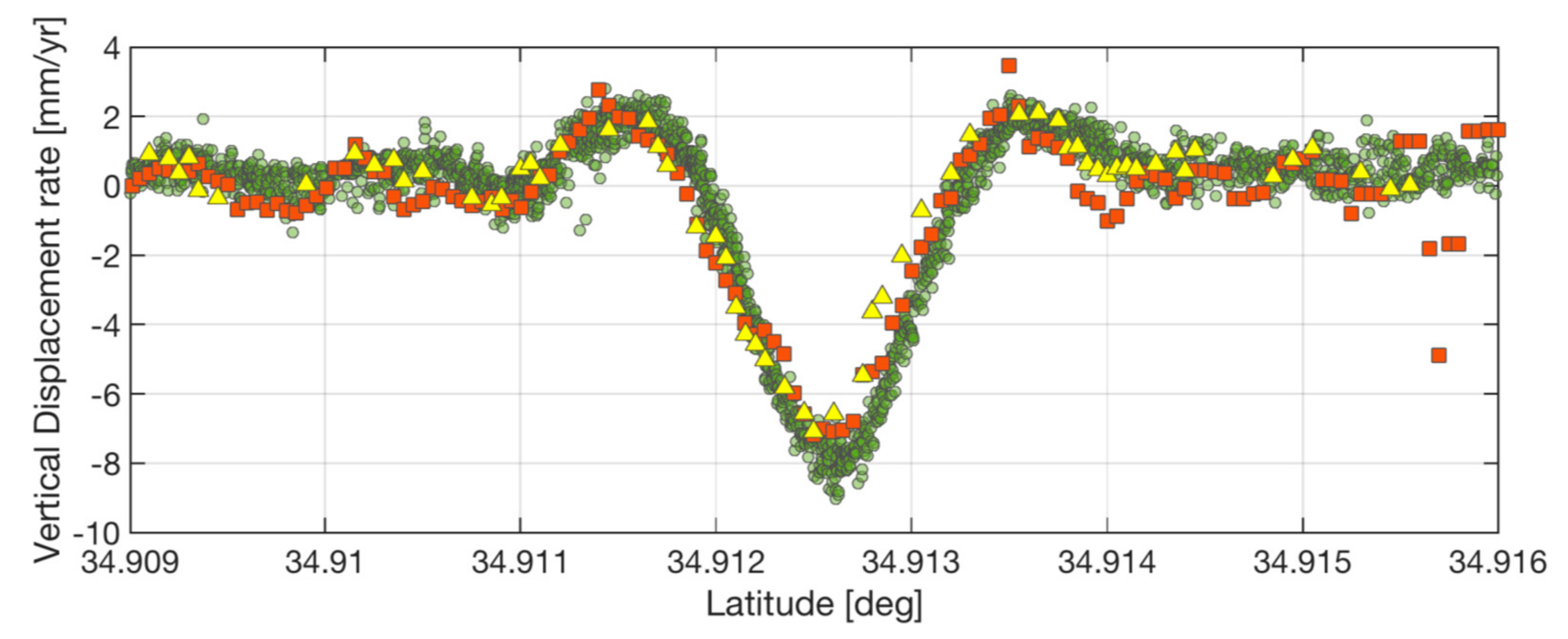
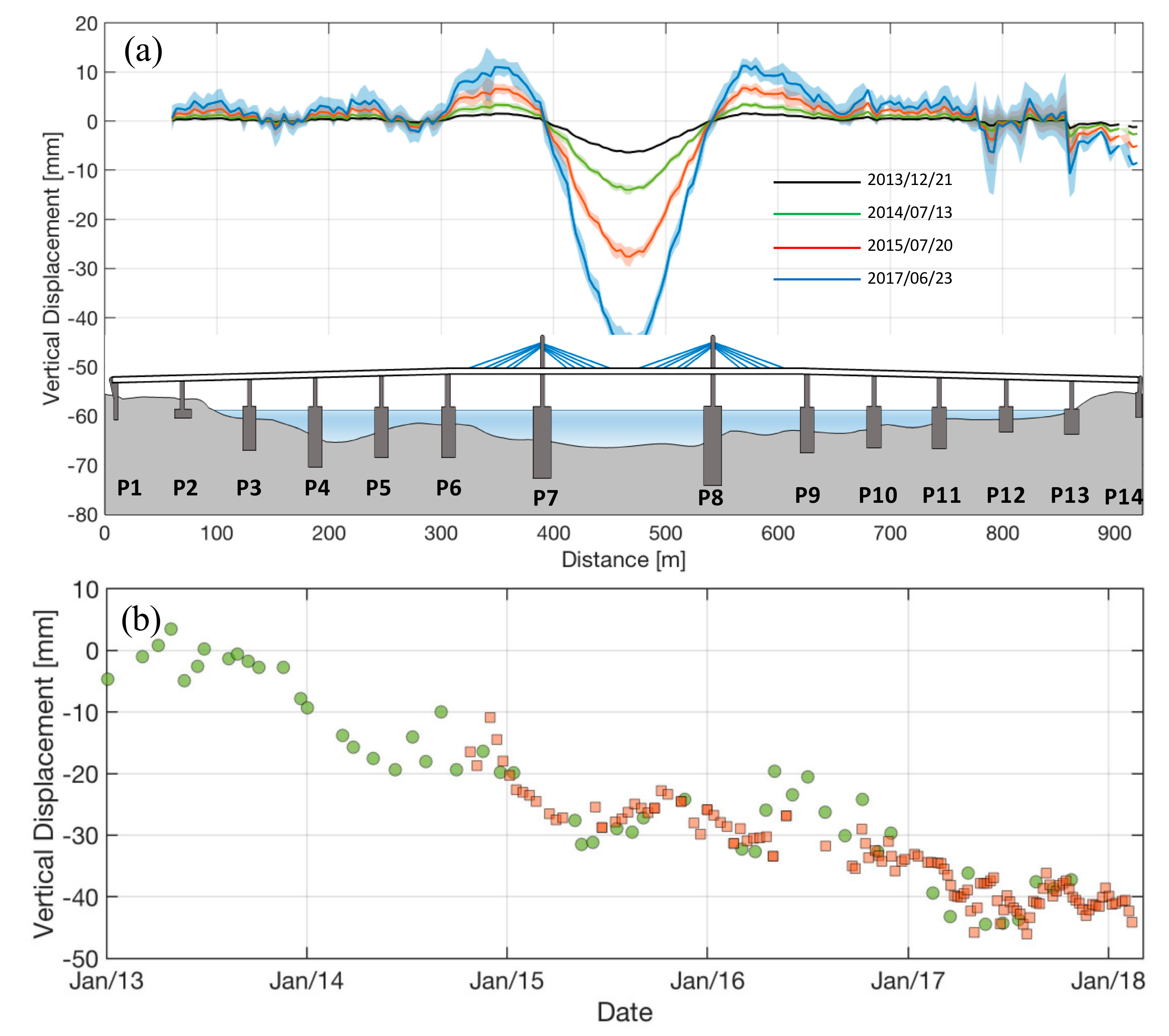
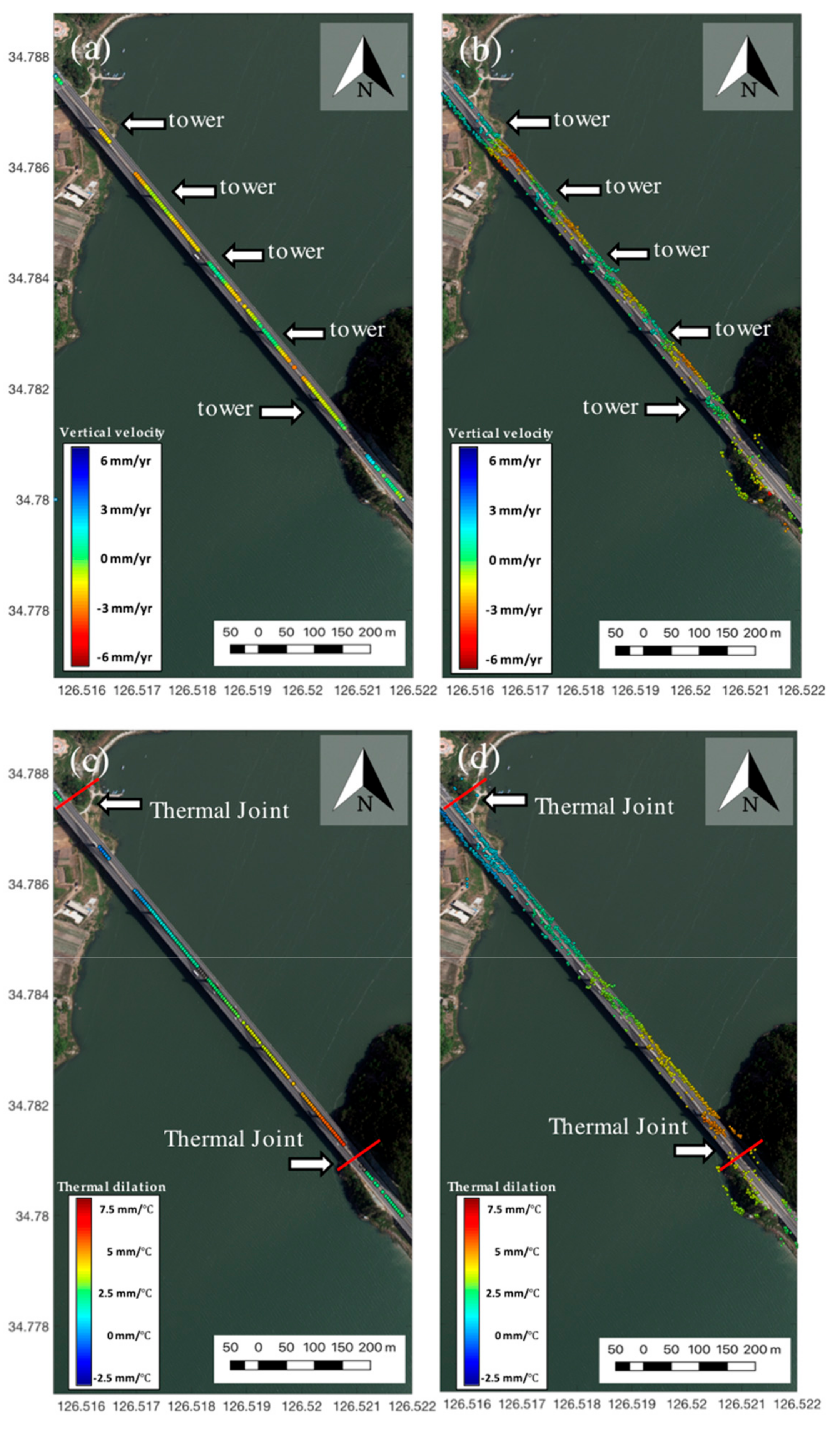
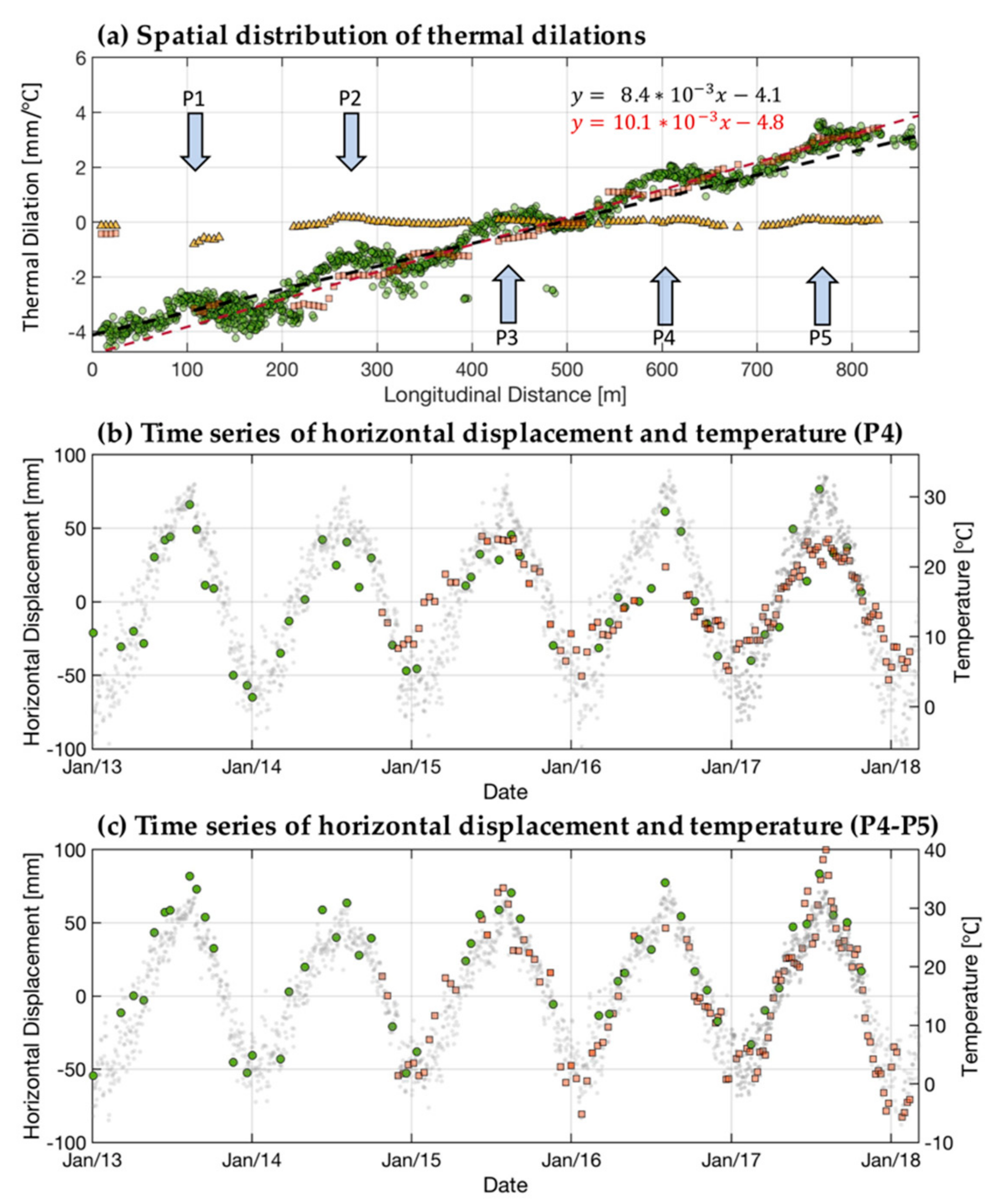
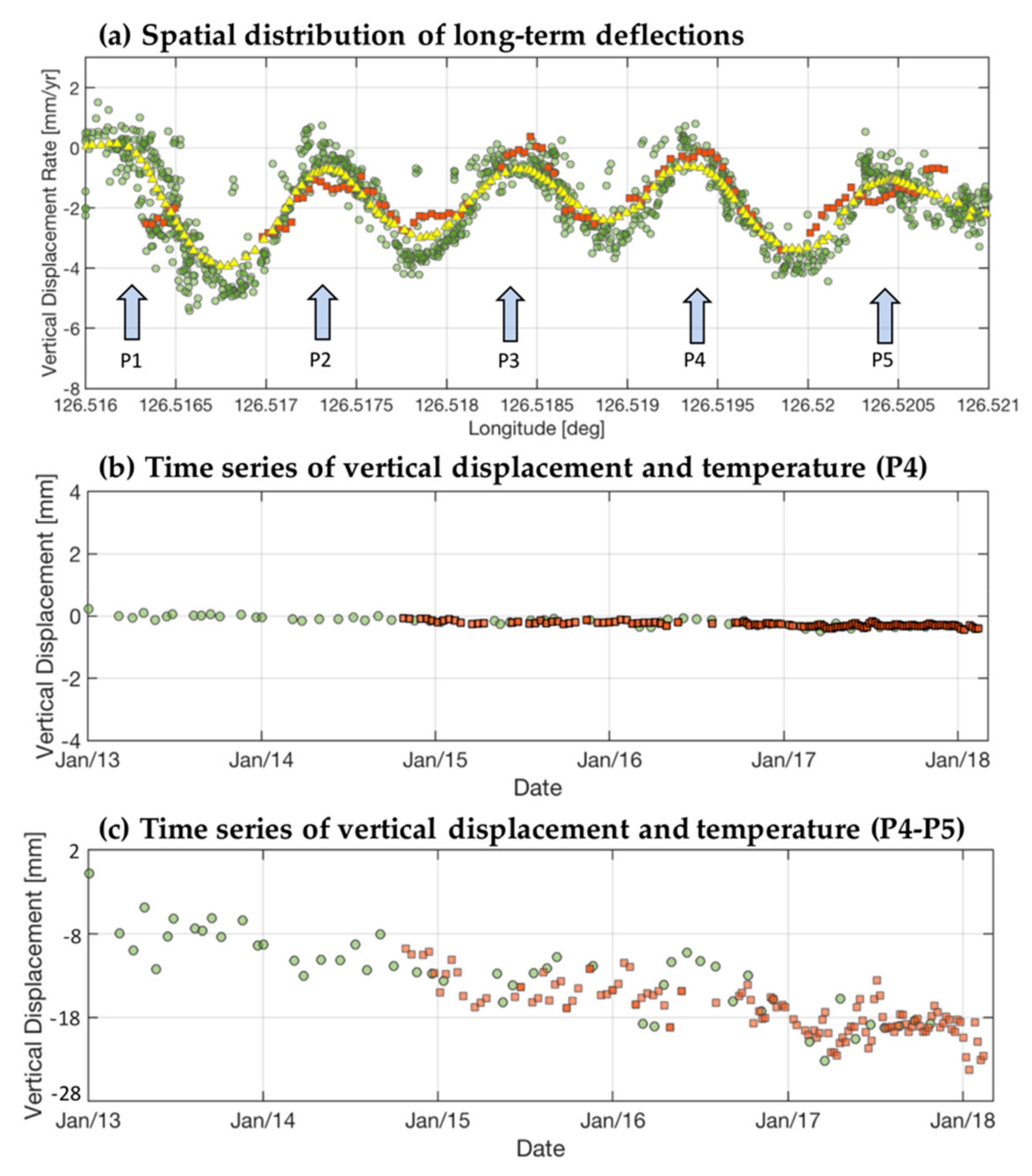
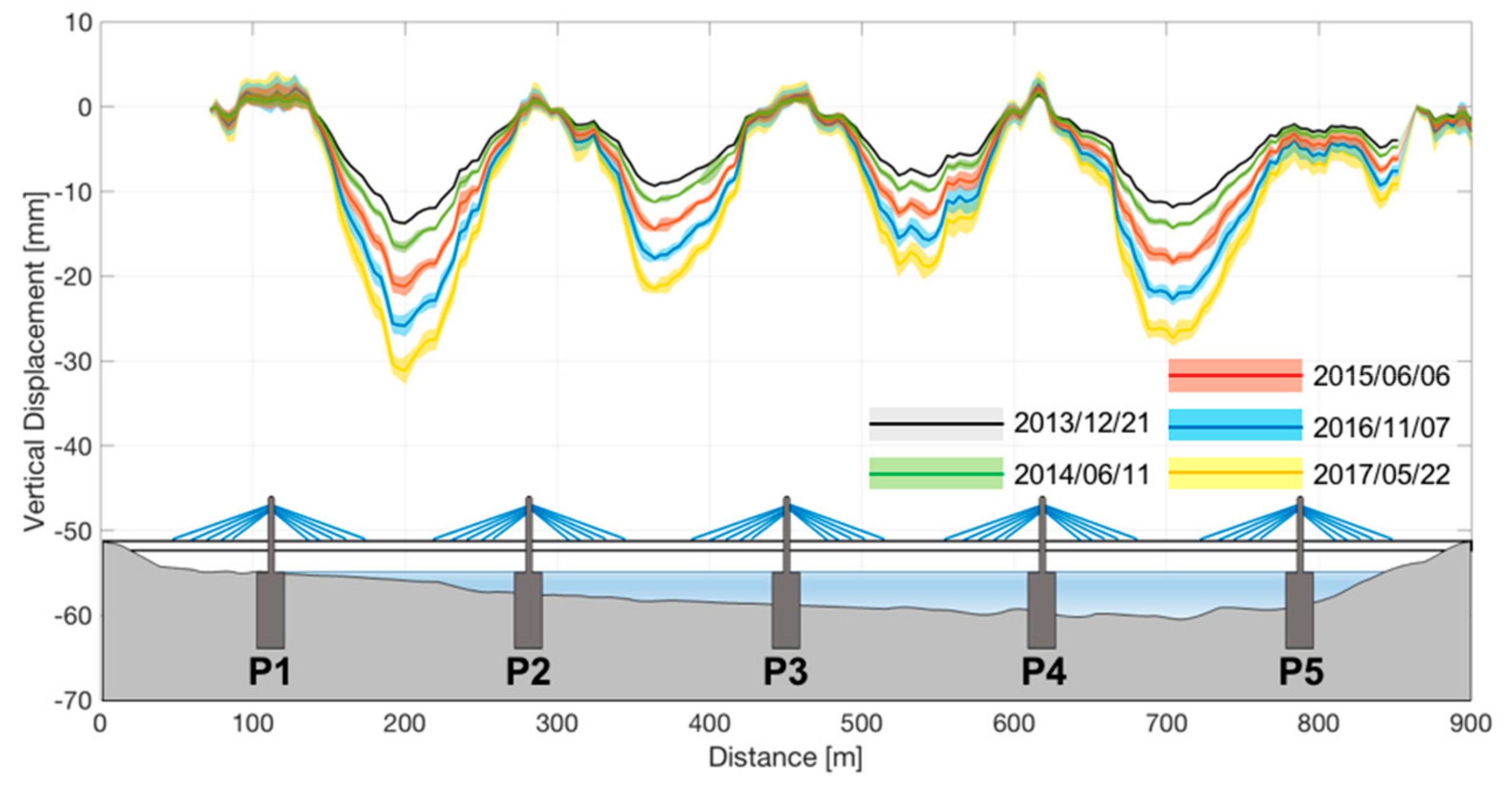
| Description | Descending (CSK) | Ascending (S1) | Descending (S1) |
|---|---|---|---|
| Incidence angle | 27.9° | 34.4° | 43.5° |
| Azimuth heading angle | 191° | −11° | 191° |
| Angle difference ( | 2° | −199° | 2° |
| Description | Descending (CSK) | Ascending (S1) | Descending (S1) |
|---|---|---|---|
| Incidence angle | 26.3° | 35.2° | 42.5° |
| Azimuth heading angle | 191° | −11° | 191° |
| Angle difference ( | 25° | −133° | 25° |
| Sensors | CSK | S1 Asc. | S1 Des. | CSK | S1 Asc. | S1 Des. |
|---|---|---|---|---|---|---|
| Bridge | Kimdaejung Bridge | Muyoung Bridge | ||||
| Number of PS | 2531 | 311 | 314 | 1320 | 239 | 327 |
| Total pixel | 6422 | 543 | 487 | 3896 | 571 | 518 |
| Percentage (PS/Total) | 39.4% | 57.3% | 64.5% | 33.9% | 41.9% | 63.1% |
| Spatial density [number/km2] | 114,010 | 14,009 | 14,144 | 57,702 | 10,447 | 14,294 |
© 2019 by the authors. Licensee MDPI, Basel, Switzerland. This article is an open access article distributed under the terms and conditions of the Creative Commons Attribution (CC BY) license (http://creativecommons.org/licenses/by/4.0/).
Share and Cite
Jung, J.; Kim, D.-j.; Palanisamy Vadivel, S.K.; Yun, S.-H. Long-Term Deflection Monitoring for Bridges Using X and C-Band Time-Series SAR Interferometry. Remote Sens. 2019, 11, 1258. https://doi.org/10.3390/rs11111258
Jung J, Kim D-j, Palanisamy Vadivel SK, Yun S-H. Long-Term Deflection Monitoring for Bridges Using X and C-Band Time-Series SAR Interferometry. Remote Sensing. 2019; 11(11):1258. https://doi.org/10.3390/rs11111258
Chicago/Turabian StyleJung, Jungkyo, Duk-jin Kim, Suresh Krishnan Palanisamy Vadivel, and Sang-Ho Yun. 2019. "Long-Term Deflection Monitoring for Bridges Using X and C-Band Time-Series SAR Interferometry" Remote Sensing 11, no. 11: 1258. https://doi.org/10.3390/rs11111258
APA StyleJung, J., Kim, D.-j., Palanisamy Vadivel, S. K., & Yun, S.-H. (2019). Long-Term Deflection Monitoring for Bridges Using X and C-Band Time-Series SAR Interferometry. Remote Sensing, 11(11), 1258. https://doi.org/10.3390/rs11111258






